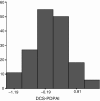Factors associated with the difference in score between women's and doctors' decisional conflict about hormone therapy: a multilevel regression analysis
- PMID: 12940794
- PMCID: PMC5060192
- DOI: 10.1046/j.1369-6513.2003.00234.x
Factors associated with the difference in score between women's and doctors' decisional conflict about hormone therapy: a multilevel regression analysis
Abstract
Objective: To explore factors associated with the difference in score between women's and doctors' decisional conflict about hormone therapy (HT).
Design: Secondary analysis.
Setting and participants: family doctors were randomized to prepare women for counselling about HT using either a decision aid or a pamphlet.
Main variables studied: After each counselling session, decisional conflict was assessed in women and doctors using the Decisional Conflict Scale (DCS) and the Provider Decision Process Assessment Instrument (PDPAI), respectively. The difference in score between the DCS and PDPAI was computed and entered as the dependent variable in a multilevel regression analysis.
Main outcome results: A total of 40 doctors and 167 women were included in the analysis. The intra-doctor correlation coefficient was 0.25. Factors associated with women experiencing higher decisional conflict than their doctor were: age of doctor >45 years, women who were undecided about the best choice after the counselling session, women with a university degree and women who said that their doctor usually does not give them control over treatment decision. Factors associated with doctors experiencing more decisional conflict than women were: doctors who were undecided about the quality of the decision, length of visit <30 min and women who thought that the decision was shared with their doctor.
Conclusion: In order to reduce the disparities between women's and doctors' decisional conflict about HT, interventions aimed at raising awareness of doctors about shared decision-making should be encouraged.
Figures


References
-
- Cegala DJ, McNeilis KS, McGee DS, Jonas AP. A study of doctors’ and patients’ perceptions of information processing and communication competence during the medical interview. Health Communication, 1995; 7: 179–203.
-
- Grol R, Wensing M, Mainz J et al. Patients’ priorities with respect to general practice care: an international comparison. Family Practice, 1999; 16: 4–11. - PubMed
-
- Hampson SE, Hibbard JH. Cross‐talk about the menopause: enhancing provider‐patient interactions about the menopause and hormone therapy. Patient Education and Counseling, 1996; 27: 177–184. - PubMed
-
- Rothert ML, Holmes‐Rovner M, Rovner D et al. An educational intervention as decision support for menopausal women. Research in Nursing and Health, 1997; 20: 377–387. - PubMed
Publication types
MeSH terms
LinkOut - more resources
Full Text Sources
Medical

